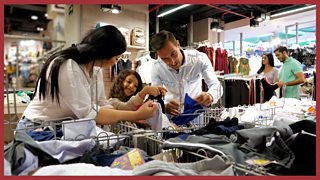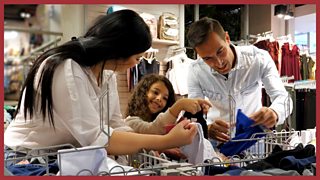Where do our clothes come from?
Themes: Clothes; working as a team; appreciating the efforts of others.
Summary: It has been calculated that in the UK we spend as much as £44 billion on clothes - including £8 billion on children's clothes. The video features a group of teenagers trying a day's work in a UK clothes factory. The assembly explores what our clothes are made of, where they come from and invites us to appreciate the effort that has gone into making our clothes.
Resources: an image to display of .
Key links
-
![]()
Download / print the framework ready for use (pdf)
-
![]()
Click on the thumbnail image to display full-size
The video:

Our clothes are big business: it's been calculated we spend up to £44 billion in the UK on clothes each year. The video explores the types of material our clothes are made of - including natural and synthetic fabrics.
A group of teenagers are invited to try a day's work in a busy clothes factory in the UK: they try cutting, stitching, ironing and packing. They find the work very challenging but by the end of the day they are getting the hang of things.
The video ends by inviting us to think when we go shopping for clothes about all the hard work that goes into making them.
Duration: 4' 05"
End of speech: '...the men and women in Mick's busy factory.'
Video questions
1. How much money is spent each year on clothes in the UK?
The figures quoted in the video are £44 billion - with children's clothes accounting for £8 billion of that
2. What types of fabric are our clothes made from?
Natural fabrics - such as cotton
Synthetic ('man-made') fabrics - such as polyester
3. What is a surprising ingredient of polyester mentioned in the video?
Oil
4. What two countries are mentioned where many of our clothes are made?
Bangladesh and China - but around 10% of our clothes are still made in the UK
5. What different stages of production happen in the factory?
Cutting the fabric
Stitching using sewing machines
Ironing the garments
Quality control
Packing
Then the clothes are ready for distribution
Suggested framework
| Content | Guidance |
|---|---|
| 1. Entry | There are plenty of songs about fashion you might choose to use - eg 'Fashion' by David Bowie or 'Fashion' by Madonna. |
| 2. Introduction | Tell the pupils that today they will be finding out about clothes: where they come from and how they are made. Ask them to think about the clothes that they wear when they are watching the video - what they like to wear and where they buy them. |
| 3. The video | Play the video. The duration is 4' 05" and the final words are: '...the men and women that work in Mick's busy factory.’ |
| 4. After the video | Use the Video questions as prompts to lead a discussion about the video: 1. ‘This video taught us all about clothes. Can anyone remember how much money we spend on clothes in the UK?’ (The figures given are £44 billion and £8 billion on children’s clothes, but you are looking for an awareness of the vast amount that is spent). 2. ‘Can anyone remember what types of materials our clothes are made from?’ (Natural materials and man-made materials). Wait for responses. Follow-up with ‘Can you remember the two most common types of fabrics mentioned in the video?’ (Cotton and polyester). 3. What clothes mentioned in the video were made from polyester? (Tracksuits and swimming costumes). 4. ‘The video showed factories where clothes are made. Can anyone remember which countries were mentioned?’ (You are looking for an awareness of China and Bangladesh but also the UK, where 10% of clothes are still made). 5. ‘How did the young people in the video find making the clothes and using the sewing machines?’ (An awareness that they found it difficult: they had to focus on lots of things and had to concentrate and not make mistakes). |
| 5. Time to talk | Ask the children to turn to their neighbour and ask them what their favourite item of clothing is - where it came from and why they like it. Allow time and then share some examples. |
| 6. Opportunity to sing | Suggestions from Â鶹ԼÅÄ collections below. |
| 7. Opportunity to reflect | Focus your reflection on thinking about the clothes we have and the hard work that goes into making them. Ask the children to think about how they treat their clothes and to reflect on how they can look after what they have. |
| 8. Opportunity for prayer | Begin with your usual form of address ('Dear God', 'Lord Jesus', 'Let us pray' etc) and: 'We thank you for all that we have and to show our appreciation to the men and women from all around the world who work hard to make our clothes. Help us to take care of what we have and be grateful. Let us think of those who are less fortunate than us. Amen.' |
Suggested songs
| Title | Collection | Significant words |
|---|---|---|
| 'Together' (Video - see 'Related links') | All about our school, no 13 | 'Work together, not alone'...'Work together, hand in hand' |
| 'While we live we learn' (Video - see 'Related links') | All about our school, no 3 | 'While we live we learn'...'While we learn we grow' |


